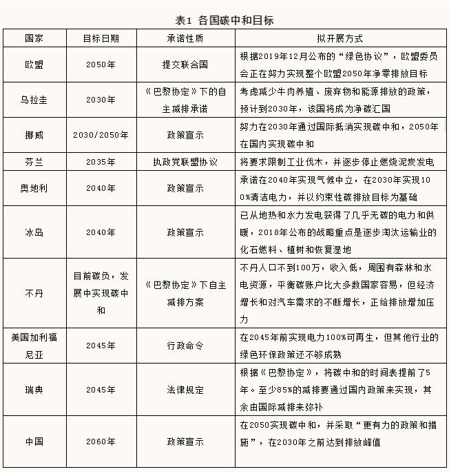Clicking on and focusing on the blue font vapor above, the garbage cloud continues to bring you high-quality tweets
. 
In December 12, 2020, China’s president Xi Jinping delivered a speech to commemorate the 5th anniversary summit of climate summit signed by the Paris agreement, which is to “carry on the past and open up the world to tackle the new climate change”
. 
It promised that by 2030, the carbon dioxide emissions from China’s gross domestic product will be lower than that of 2005
. 
Reduce the carbon consumption by more than 65% and strive to achieve “carbon neutrality” by 2060
.
This is a strategic move that China is committed to the construction of its own ecological civilization and a major declaration that China is willing to make new contributions to the development of human society
.
However, facing the increasingly complex international situation, it is a very urgent and challenging task for China to plan and improve the low-carbon development path and achieve “carbon neutrality” by what means
.
The long-term goal of the Paris Agreement on climate change is to control the global average temperature rise within 2 ℃ compared with the pre industrial period, and strive to limit the temperature rise within 1.5 ℃
.
The agreement was signed by 178 countries on April 22, 2016 and came into force on November 4, 2016
.
After the signing of the agreement, all the contracting parties have set their own carbon neutral timetable, among which the EU has set a consensus target of 2050; most other countries (including the neighboring South Korea and Japan) have basically set a timetable of reaching the target by 2050; a few countries have set earlier completion time targets according to their own development (Table 1)
.
Carbon neutral road of construction industry: energy consumption in the whole process of construction includes production energy consumption of main building materials consumed by construction industry (including infrastructure), construction energy consumption of construction industry, and operation energy consumption of existing buildings; The carbon emission of the whole process of construction includes the carbon emission from the production of main building materials consumed by the construction industry (including infrastructure), the carbon emission from the construction industry, and the carbon emission from the operation of existing buildings
.
According to the statistics of the energy consumption statistics special committee of China Building Energy Efficiency Association, the total energy consumption of the whole process of construction in 2018 is 2.147 billion TCE, accounting for 46.5% of the total energy consumption of the country
.
Among them, 1.1 billion TCE is consumed in building materials production stage, accounting for 46.8% of the total national energy consumption; 47 million TCE is consumed in building construction stage, accounting for 2.2% of the total national energy consumption; 1 billion TCE is consumed in building operation stage, accounting for 21.7% of the total national energy consumption
.
In 2018, the total carbon emission of the whole process of construction in China was 4.93 billion tCO2, accounting for 51.3% of the national carbon emission
.
Among them: the carbon emission of building materials production stage is 2.72 billion tCO2, accounting for 28.3% of the national carbon emission; the carbon emission of building construction stage is 100 million tCO2, accounting for 1% of the national carbon emission; the carbon emission of building operation stage is 2.11 billion tCO2, accounting for 21.9% of the national carbon emission
.
Data source: China Building Energy Consumption Research Report (2020) four scenarios of future carbon emissions based on building energy efficiency: under the background of China’s rapid urbanization, the expansion of urban building area and the increase of energy consumption accompanied by building expansion can not be ignored, and the urban residential building energy consumption in China can not be ignored, Urbec) has increased from 309mtce in 2001 to 857mtce in 2015
.
Improving energy efficiency is a key way to reduce urbec, and how to effectively measure energy efficiency is of great significance
.
The construction sector is the key area to achieve the goal of carbon neutralization
.
The construction sector should take negative carbon technologies such as building efficiency, building capacity, building electrification and power decarbonization, carbon sequestration and carbon sequestration as emission reduction paths
.
Under this path, China’s building carbon neutral will have the following four emission scenarios: 1
.
Energy saving scenario (S1): improving building energy efficiency and reducing building energy consumption under the premise of benchmark scenario; 2
.
Capacity scenario (S2): under the premise of energy saving scenario, building energy efficiency has been improved based on low-carbon path, and building energy consumption has shifted to production energy (such as solar power generation); 3
.
Decarbonization Scenario (S3): under the premise of capacity scenario, based on the low-carbon path, buildings can generate energy, and can output clean energy through the building microgrid, while the proportion of green power utilization is increased; 4
.
Carbon neutral scenario (S4): under the decarbonization scenario, based on the low-carbon path, buildings mainly use their own energy and take clean energy as supplement, and the remaining carbon emissions are through carbon sink and carbon sequestration And other technologies to achieve carbon neutral, to achieve the building completely positive climate impact
.
Data source: China Building Energy Consumption Research Report (2020) in the benchmark situation, the peak time of building carbon is 2040, and the carbon emission in 2060 is 1.5 billion tCO2, which will seriously restrict the realization of the national carbon peak and carbon neutral target
.
Under the scenarios of energy saving and production capacity, the goal of building carbon peak can be achieved by 2030
.
Under the benchmark scenario, 1.5 billion tCO2 is difficult to achieve neutralization
.
By 2060, the construction sector can reduce emissions by 72%, and the remaining 28% is about 400 million tons of carbon emissions, which need to be neutralized by negative carbon technology
.
To achieve the peak of building carbon emissions in 2030, the total building carbon emissions should be controlled at 2.5 billion tCO2 and the annual growth rate should be controlled at 1.50% by the end of the fourteenth five year plan
.
Meanwhile, the total building energy consumption should be controlled at 1.2 billion TCE and the annual growth rate should be controlled at 2.20% by the end of the fourteenth five year plan
.
Under the carbon peak target, the total building energy consumption should be controlled at 1.2 billion TCE, the carbon emission should be controlled at 2.5 billion tons, and the average annual growth rate of carbon emission should be controlled at 1.5%
.
Source: China’s building energy consumption Research Report (2020): Disclaimer: the content, source of pictures, Internet, official account of WeChat, etc.
.



